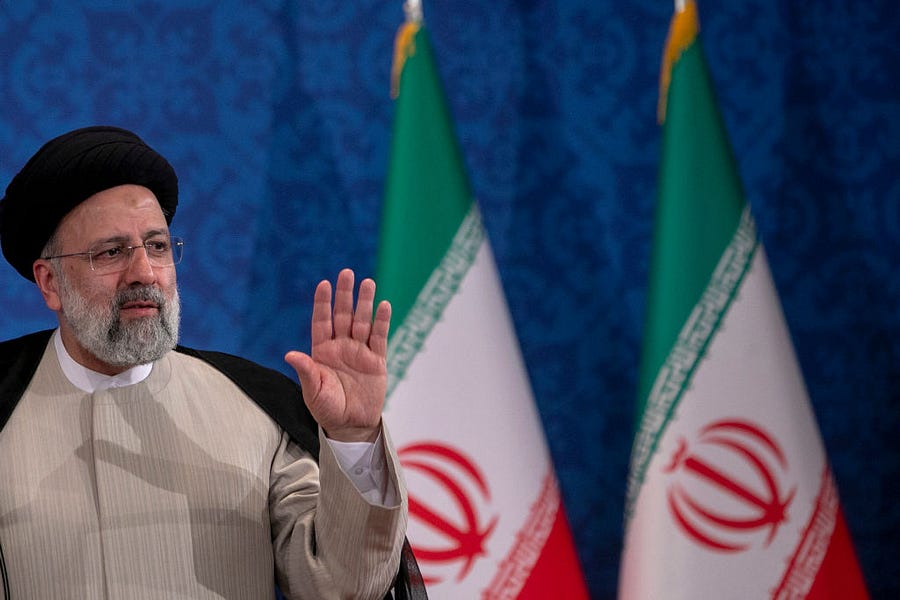With the world’s eyes on Kabul over the weekend, the Butcher of Tehran paid a visit to Iran’s Khuzestan province. Iran’s newly inaugurated president, Ebrahim Raisi, struck a conciliatory tone in the province mired in anti-government protests earlier this summer: “Khuzestan province has very good people, and they have done their best to defend the country at different times, and we owe them a great deal.”
Meanwhile, back at the nation’s capital, Iran’s parliament continued the work of confirming a cabinet made up of international terrorists and leading human rights abusers. Raisi’s picks for interior minister and vice president of economic affairs, Ahmad Vahidi and Mohsen Rezai respectively, are perhaps best known for their roles in the 1994 bombing of an Argentinian Jewish center in which 86 people were killed.
With the true colors of Supreme Leader Ali Khamenei’s top-down government on full display to anyone invested enough to look, placatory rhetoric and veiled threats from Raisi down are unlikely to get the incoming administration far with Iranians, particularly given their growing recognition of the regime’s hand in everyday hardships.
“There’s joblessness, inflation, no hope, nothing,” Arash, a Tehran-based businessman, told The Dispatch. “Basically, the whole country is screwed.”
Most outsiders place the beginning of Iran’s latest swell of unrest in mid-July, when local grievances over water shortages in Khuzestan province escalated to nationwide calls for regime change. But in Arash’s memory, anti-Islamic Republic demonstrations have been a fixture in his home country for four years and counting. With five mass protests since 2017 and smaller displays of civil disobedience sprinkled between, low-grade insurrection is the country’s new norm.
In Khuzestan—the province containing 80 percent of Iran’s oil fields and 60 percent of its natural gas reserves, the country’s primary exports—Iranians are poverty-stricken and thirsty. About 700 villages faced critical water shortages over the summer, ravaging crops and killing livestock. And the regime saw it coming.
Mohammad Hossein Shariatmadar, head of Iran’s national center for strategic agriculture and water management studies, warned in 2018 that the government’s decades-long “water mismanagement” had brought the country “only five years away from an all-encompassing water disaster.” Unsustainable oil and natural gas production, along with ongoing projects diverting water from the Karun River to the country’s landlocked provinces, renders Khuzestan particularly vulnerable to environmental catastrophes.
The regime responded last month, as is its wont in the face of unrest, firing off live ammunition and birdshot to disperse peaceful crowds and detaining participants en masse. According to the Human Rights Activists News Agency (HRANA), dozens of protesters were killed—including two children under the age of 16—and 361 more were arrested since the province’s demonstrations began on July 15.
When asked if he knows personally anyone who supports the Iranian government, Arash answered without hesitation: “No. As far as I understand, nobody likes the regime at all. Whatsoever.”
In the same gatherings where discontented farmers, shop owners, and oil workers shouted “we are thirsty,” they also recited anti-regime slogans, some of which have reverberated across Iranian cities for a decade: “We don’t want an Islamic Republic!” “death to the dictator,” “don’t be afraid, we are all together!” “from Tehran to Khuzestan, unity, unity!”
Saeed, a student from Bushehr City, traveled to Khuzestan during the protest’s height this summer to bring much-needed provisions to those wounded in the crackdown. “The regime tried to just say that it’s water and electricity that’s the issue, but I was there,” Saeed told The Dispatch. “I spoke to the people of Khuzestan and they said it was just the start, on day one, but their hatred is the Islamic Republic and the regime.”
Still, Tehran was quick to displace responsibility for the resource shortages from misgovernance and onto things like climate change, Arab separatists, and the Trump-piloted “maximum pressure” sanctions regime.
Like Raisi, Supreme Leader Khamenei paid lip service to the protesters’ grievances.
But the ayatollah also warned the people of Khuzestan not to let the “enemy” capitalize on their hardships. “The enemy wants to take advantage of every small matter against the country, the Revolution, the Islamic Republic and the public interests of the people,” Khamenei said in a post to his official website. “The people should take care not to let the enemy take advantage of the situation and not to give the enemy any pretext whatsoever.”
The government quashed mobile data access during the demonstrations, which served the dual purpose of impeding large gatherings and concealing the security forces’ brutal response from other Iranians and the international community. State-sponsored press, meanwhile, published videos of the deceased’s family members blaming their deaths on “rioters” and condemning the “counter-revolutionary” media’s spin. Amnesty International later confirmed that the statements were coerced.
“It’s clear that at every opportunity given to the people, they’ve come out on the streets to signal that this regime doesn’t represent them, this regime is ruining their country’s name and reputation abroad, and this regime is spending their resources on things they don’t support and things that actually cause long-term harm,” said Behnam Ben Taleblu, a senior fellow focusing on Iran at the Foundation for Defense of Democracies.
The post-1979 government’s expansionist vision, carried out primarily through its support for regional terror, redirects money and attention from the Iranian people and outsources the country’s governance to military commanders. A chant often invoked at anti-government protests—“Not Gaza, Not Lebanon, My Life For Iran”—takes aim at the regime’s backing of Hamas and Hezbollah. Other Iranian proxy groups in Yemen, Iraq, Syria, the West Bank and elsewhere further the Islamic Republic’s ultimate goal of exporting the revolution.
“It’s unbelievable, because after 40 years we don’t have anything. We don’t have water, we don’t have power, we don’t have anything,” Arash said, adding that the billions of dollars in sanctions relief granted to Iran under the Obama-brokered nuclear deal circumvented its citizenry and went instead to arms purchases. “China and Russia got that money, that’s it. The people didn’t get anything.”
“We want sanctions to be continued, or even strengthened, because if they loosen sanctions, all there’s going to be is additional bullets to kill us and create chaos in the Middle East,” Saeed said.
Indirect negotiations between the U.S. and Iran to reinstate the 2015 Joint Comprehensive Plan of Action (JCPOA) stalled in June following the election of Raisi, Khameini’s hand-picked candidate, temporarily halting Tehran’s efforts to leverage its enrichment program to secure desperately-needed cash. And the Iranian government, fearing a miscalculation of Biden’s determination to re-enter a deal, is lashing out at its assumed allies in the White House.
“The current U.S. government is no different from the previous one. They demand the same thing that Trump demanded,” Khamenei reportedly said Saturday. “Behind the scenes of U.S. foreign policy there lies a predatory wolf that sometimes changes into a cunning fox.”
But the Biden administration remains motivated to reach a diplomatic agreement with Iran, the president told Israeli President Naftali Bennett on Friday, particularly as the regime ups its enrichment of uranium to 60 percent and threatens to reach weapons-grade enrichment levels..
“From 2017 to present, the Iranian people have been more willing than ever to go out onto the streets and more willing to seek revolution over reform. And that point seems to be missing in discussions of Iran policy in Washington, whether they’re pro-JCPOA or anti-JCPOA. The reason it matters is that it puts potential expiration dates on any behavior change policy or non-proliferation policy by Washington toward Tehran,” Taleblu told The Dispatch. “A scenario they will have to prepare for is the potential for regime collapse, and flesh out what that may look like.
So what does anticipating the possibility of Iranian regime change actually look like? The sticky phrase conjures to American minds a two-century history of covert and overt U.S. meddling in Latin America, Europe, Asia, and elsewhere. But in the case of Iran, opponents of the government just want to be heard.
“Don’t follow the Iranian government, just listen to the people of Iran,” Arash said. “People in Iran—they love the American people—but unfortunately the government of Iran, it doesn’t represent the Iranian mentality whatsoever.”
One figure who does enjoy broad appeal among Iranians is Reza Pahlavi, the eldest son of Iran’s last monarch.
In October 2016, thousands of Iranians surrounded the tomb of Cyrus the Great, the ancient ruler of the first Persian empire, to chant “Pahlavi! Pahlavi!” in anti-regime protests. Ever since, Iranians have invoked the Pahlavi family, dynasty, and idea to demonstrate their opposition to the revolution that toppled the Shah and established the Islamic Republic in 1979. “Reza Shah, bless your soul,” was one of the many slogans chanted at this summer’s demonstrations, in reference to the founder of the dynasty.
The support for the grandson of the first shah doesn’t indicate a call for monarchy—Pahlavi himself supports democracy in Iran—but rather a fundamental shift away from the revolution’s ideology and leadership among Iranians. The Pahlavis carry symbolic weight precisely because of their taboo within modern Iran.
“Ever since we’re 10 years old, our history books start attacking the Pahlavis. This regime will say anything, do anything, and has done everything to try to discredit the Pahlavis—saying that they are killers, they are drug dealers, anything you can think of,” Saeed said. “The supreme leader of the regime, in 2019, went on TV and said the Pahlavi family is responsible for these protests and uprisings. He showed how scared he was by naming them.”
“It’s a key period of modern Iran history that I think youth who are inquisitive and reject the country’s mainstream narrative about what happened in the past century are interested in and are discovering,” Taleblu said.
Iranians’ burgeoning curiosity about the regime and its origins is not without a substantial human toll. An estimated 1,500 protesters—many between the ages of 18 and 30—were killed by security forces in a two-week period between 2019 and 2020. Many political prisoners remain in the government’s custody, where torture and violations of due process have come to be expected.
“We are going to fight for our country and free our country,” Saeed said. “We’ve lost many brave souls … but we will continue this fight and we’re going to continue this resistance.”









Please note that we at The Dispatch hold ourselves, our work, and our commenters to a higher standard than other places on the internet. We welcome comments that foster genuine debate or discussion—including comments critical of us or our work—but responses that include ad hominem attacks on fellow Dispatch members or are intended to stoke fear and anger may be moderated.